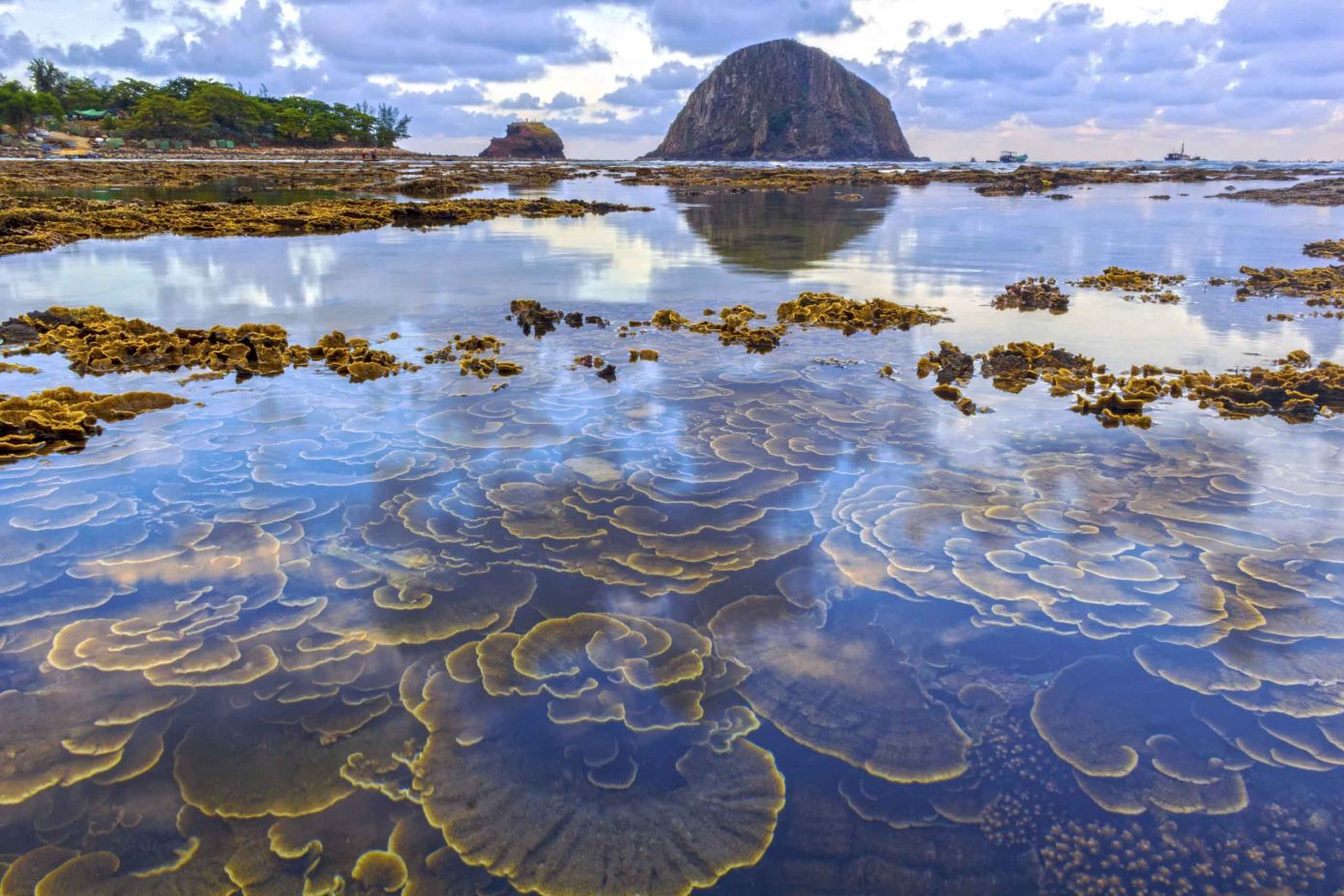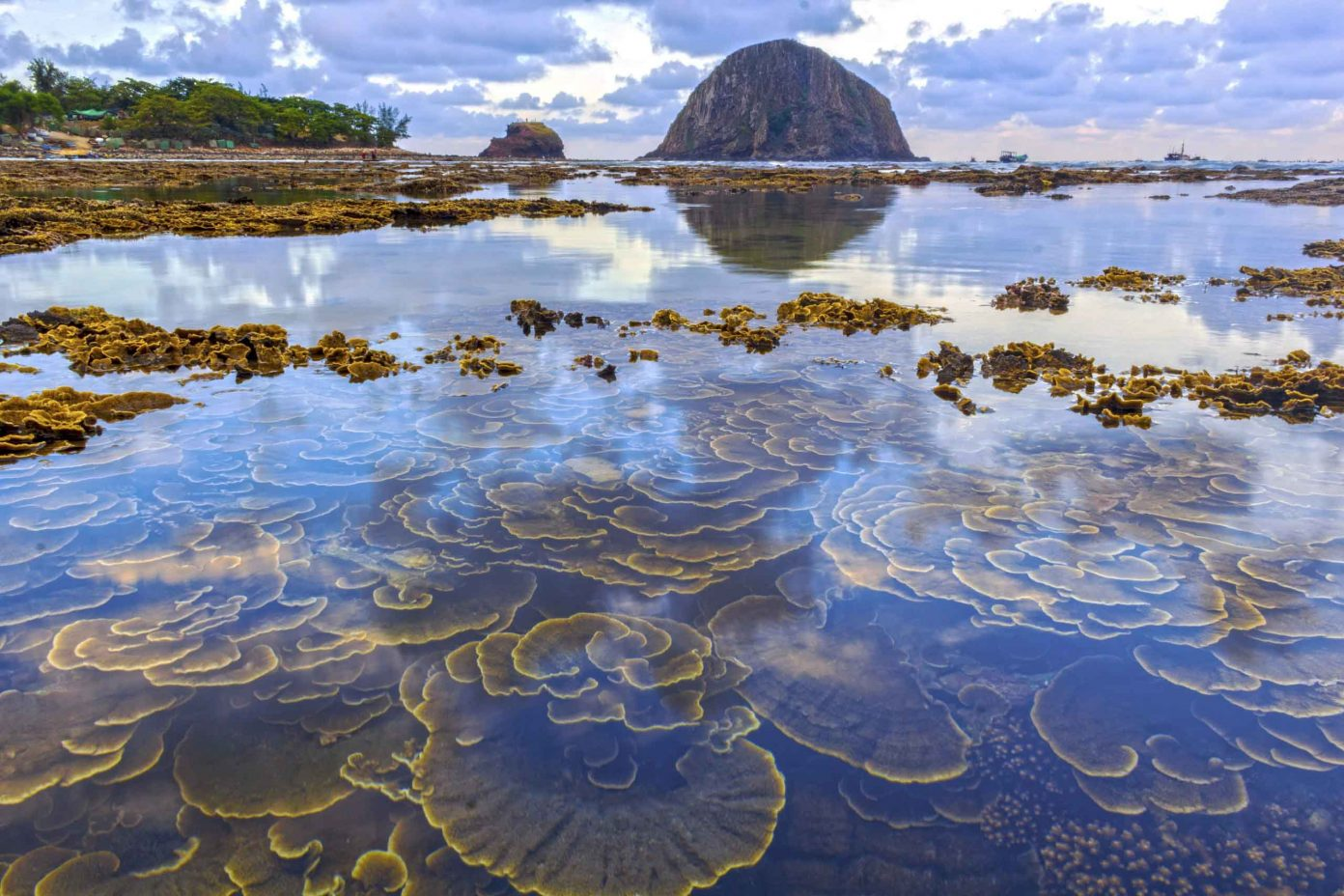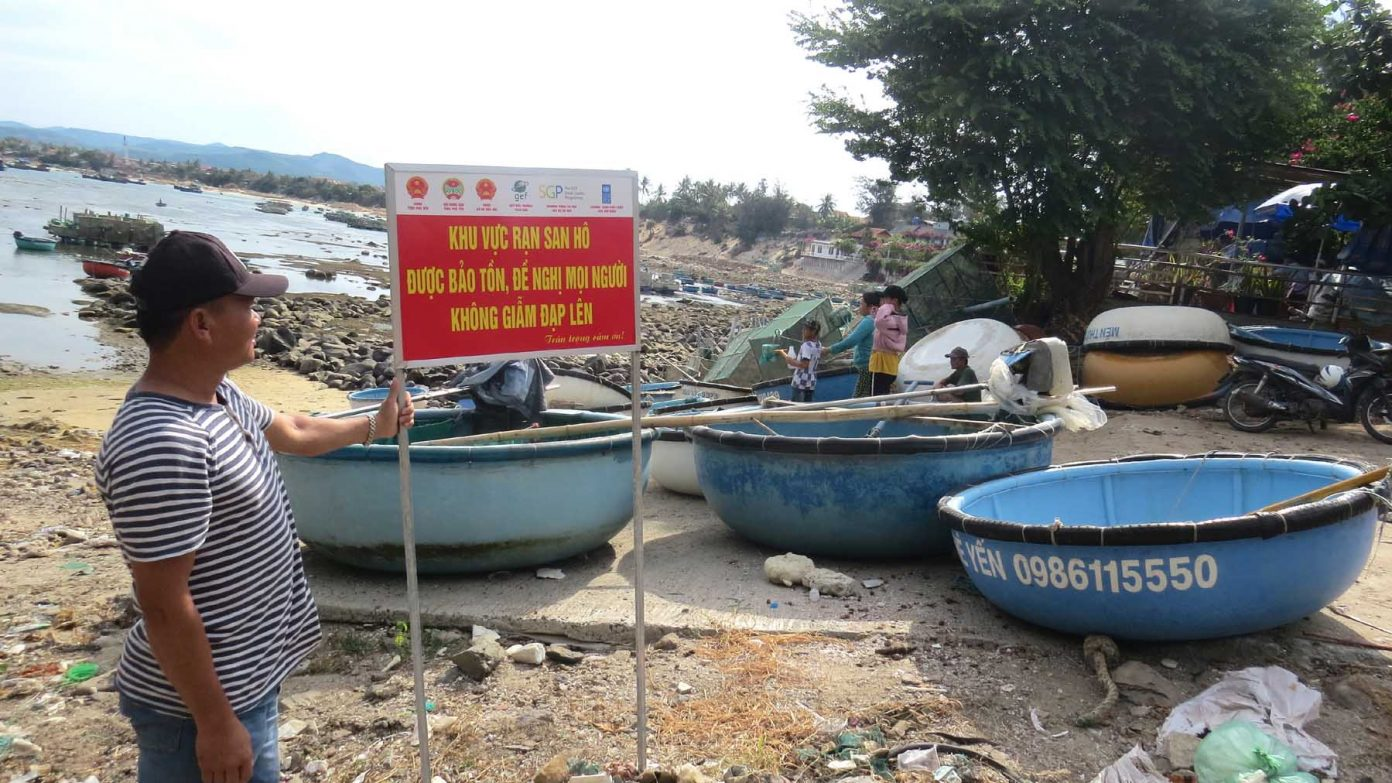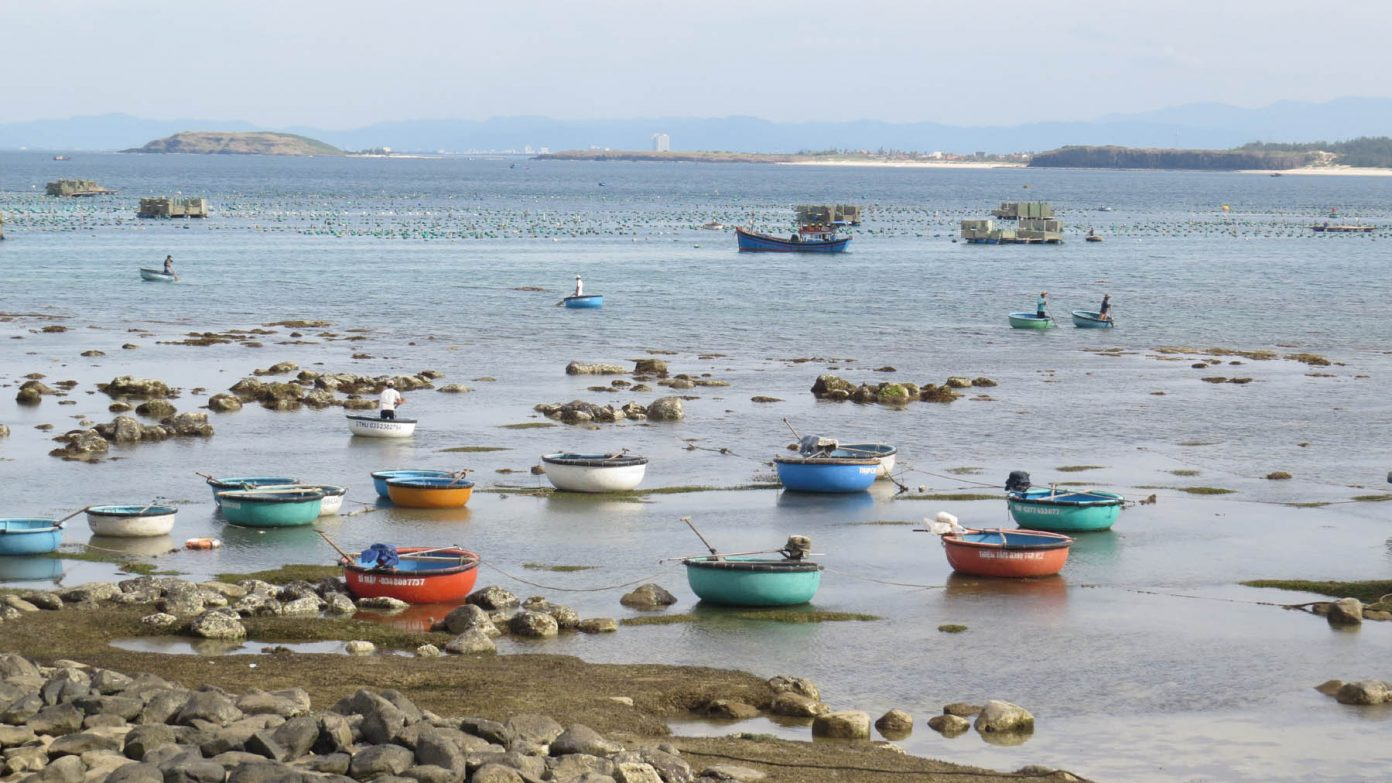
Take a Basket Boat to Hon Yen to See the “Coral Blooming”
Recently, many people and tourists trampled openly in Hon Yen to seek beauty, check in, and "suffer" coral. The community holds numerous meetings to discuss coral protection measures in order to protect the corals. As a result, visitors can enjoy coral viewing from... a coracle.
The Hon Yen complex, which includes Hon Yen, Hon Dun (Hòn Sắt), Ban Than, Ganh Yen, Hon Choi, and Vung Choi, creates a stunning natural landscape on the coast of An Hoa Hai commune, Tuy An district, Phu Yen province. From geology to flora and fauna, biodiversity, this is a very valuable natural landmark. Hon Yen, in particular, is the outstanding highlight of this scenic complex.
 Hon Yen is a popular tourist destination, especially since the Ministry of Culture, Sports, and Tourism designated it as a national scenic spot in 2018. Visitors will see rocks clinging to green moss, abundant silver waves, and golden sands running after the waves and mingling among the deep blue casuarina banks firsthand.
Hon Yen is a popular tourist destination, especially since the Ministry of Culture, Sports, and Tourism designated it as a national scenic spot in 2018. Visitors will see rocks clinging to green moss, abundant silver waves, and golden sands running after the waves and mingling among the deep blue casuarina banks firsthand.
Coral blossom season
Recently, social media spread the story of tourists trampling hon Yen coral, before the beauty like a colorful picture, the online community called for working together to protect coral.
"People here consider Hon Yen coral to be yours hidden under the sea because a year only reveals three months of summer when the tide recedes, but one day coral appears only three hours, from 15:00 to 17:00 pm, it's a time when the water drains," said Mr. Pham Tu, Head of Nhon Hoi Creek.
 According to Mr. Tu, when the receding water reveals the coral mound separating the canals, the terrestrial corals bloom in all colors, giving rise to the term "season of coral flowers blooming on land."
According to Mr. Tu, when the receding water reveals the coral mound separating the canals, the terrestrial corals bloom in all colors, giving rise to the term "season of coral flowers blooming on land."
"Concerning the formation of coral reefs, coral is a rock core that forms young and soft, hardens after 10-15 years, and then forms over a period of nearly 100 years. There are propeller-shaped corals, radiating lotus buds and duckweed ears, and multicolored overlapping cutting boards "Mr. Tu stated.
According to Mr. Le Van Kim, a member of Nhon Hoi Creek, the coral ears bend the contour, making the shape of the expanding propeller very beautiful. Visitors are bending down to look at the coral, so break it in the palm of the hand raised in front of the view.
"Soft corals and hard corals are the two types of coral mounds. Soft corals are young corals that are as small as flower buds; when someone touches coral buds with their hands, they fall off. When the trampling power is broken, the old corals die, and the waves wash up immeasurably "Kim stated.
 This coral mound can be seen from Ông Mausoleum - Nhon Hoi village temple, which is 200 meters away from Hon Yen.
This coral mound can be seen from Ông Mausoleum - Nhon Hoi village temple, which is 200 meters away from Hon Yen.
There are coral groves and thorny coral bushes of all colors in the coral forest, blue, red, yellow, purple, brown, beautiful, and magical shimmering like a paradise under the sea.
Scientists and managers from the Research Institute of Rural Agricultural Planning, Geological Museum, and Global Geopark have come in the past to rent canoes and swim baskets and study shimmering coral forests... all have the same perception, this area is pristine, the water is blue, and watching corals see fish, whereas in other places the sea near residential areas is turbid.
The Phu Yen coast is unique, with ecosystems of lagoons, bays, and coral reefs surrounding the islands that are rich in marine species waiting to be studied further. The UNESCO Global Geopark project has a lot of potential in Phu Yen in terms of geological-natural heritage and cultural heritage.
Corals of all colors, according to Kim, "lure" aquarium fish to live on the reef, and when the coral is exposed, there are snails with unusual shapes. When trampled by human footsteps, the weight weighs on the 'injured' coral, but the trampler's many steps cause the coral to die.
Coral viewing... from the basket boat
The author went down to the beach to meet a person who asked to see the coral mound in Hon Yen's backyard. "Forbid it and don't let it go!" said this person. Previously, tourists rushed out to trample, and superiors directed. Recently, the locality held 4-5 meetings to discuss coral protection measures, and the locality drafted dispatches with the message that visitors must not trample corals.
When the announcement went viral, everyone came to a halt... visitors are not permitted to trample coral on foot when they see visitors walking to the beach.
 This person went on to say that visitors who want to go to the coral must go to the basket to glide above the coral if the water is about to run out, swim in the middle of the stream, stand on the basket... and watch corals on both sides.
This person went on to say that visitors who want to go to the coral must go to the basket to glide above the coral if the water is about to run out, swim in the middle of the stream, stand on the basket... and watch corals on both sides.
Guests who want to see the panoramic view of coral can swim a basket boat around Hon Yen to see the coral under the clear blue sea from the coral mound through the coral forest. He pointed to a large forbidden sign at the road's beginning and a small forbidden sign near the shore for visitors to see.
The author returns to the mausoleum of Ong - Ba Temple, which stands nearly 100 meters above Hon Yen and is surrounded on four sides by steep rock floors. Dunes, which are nearby, are also rocky, but the lower, like a couple, appear very graceful and poetic. Deeply ingrained waves form traces of time at the foot of the rocky mountain.
"From the coral mound through Dunes to Hoa Yen, there is a coral forest nearly 100 years old under the sea stretching out in all colors," said Mr. Nguyen Ngoc Anh, also a member of Nhon Hoi Creek. Many tourists have come here in the past to sit on basket boats while watching coral and photographing Hon Yen. Hon Yen was photographed "changing color." The sun had just risen and shot from the outside into The Bird's Nest, turning it red. Hon Yen is a fiery red when the sun rises to the pole. Hon Yen is a fiery red when the sun rises to the pole. Hon Yen turns black and brown when the sun shines on it at noon. When the sun came out in the afternoon, Hon Yen turned brick red."
When asked about previous instances of people stepping on corals, Ms. Bui Thi Hue of An Hoa Hai commune stated, "I am extremely frustrated that many people who check in to take photos have no sense of protection and are willing to trample on corals. Not this year, but in previous years, when the tide recedes and the corals rise, many tourists from all over the world come here to visit and trample the Hon Yen coral ".
"The Hon Yen coral ecosystem is very valuable," said Huynh Van Khoa, Chairman of the Tuy An District People's Committee. Tran Huu The, President of the Provincial People's Committee, signed a document requesting that relevant agencies and units investigate the situation of many people, tourists, and photographers trampling on coral at the Hon Yen Complex National Scenic Monument.
In addition, the Tuy An District People's Committee will assume primary responsibility for, and coordinate with, the Department of Culture, Sports, and Tourism, as well as relevant agencies and units, in implementing effective measures to protect and conserve scenic relics as soon as possible. The District People's Committee has been informed and has directed relevant sectors to take action to protect this valuable reef."
Source: Mạnh Hoài Nam